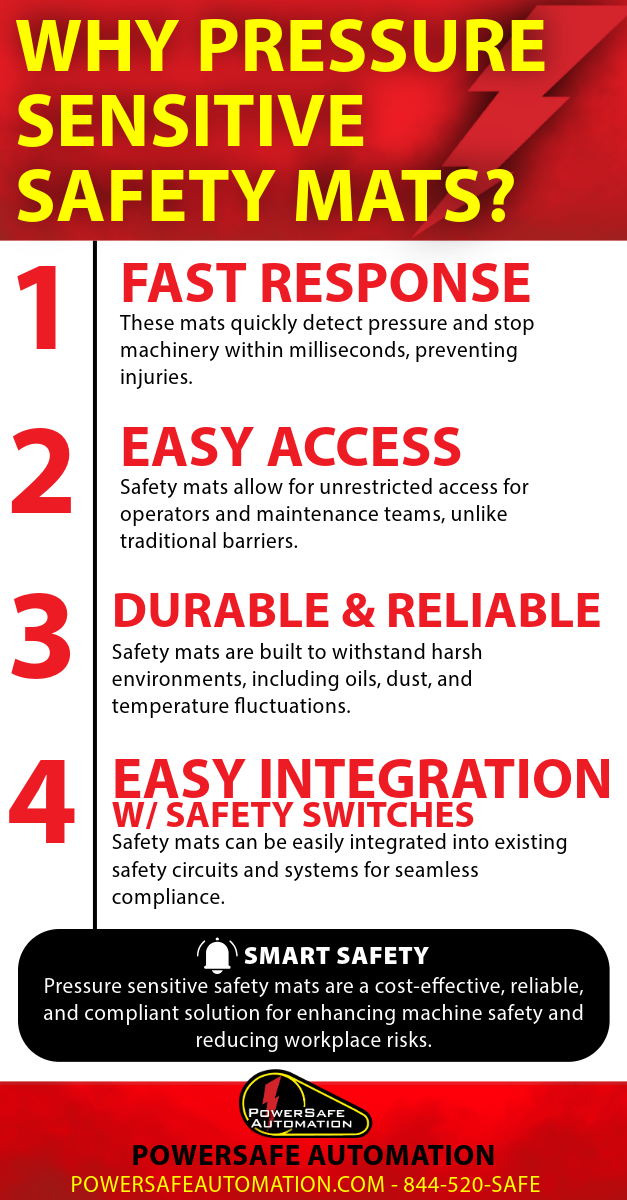In high-risk manufacturing environments, safety is not just a priority—it’s a necessity. As a Safety Manager, ensuring that workers are protected around machinery is a core part of your responsibility. One of the most effective yet often overlooked components of a comprehensive machine guarding strategy is the pressure sensitive safety mat.
What Are Pressure Sensitive Safety Mats?
Pressure sensitive safety mats are devices placed on the floor around hazardous machinery or automated systems. When stepped on, these mats immediately send a signal to shut down the machinery or stop its movement, preventing potential injury. They're part of a broader category of presence-sensing safety devices (PSSDs), designed to detect human presence in danger zones.
Key Benefits of Pressure Sensitive Safety Mats
- Rapid Response Safety Integration
- Simplified Access & Ergonomics
- Durable & Reliable in Harsh Conditions
- Easy Integration with Safety Circuits
- Robotic Work Cells – Preventing human access to moving parts.
- CNC Machines and Presses – Ensuring operator safety during loading/unloading.
- Packaging Lines – Controlling access around conveyors and automated equipment.
- Automated Storage & Retrieval Systems (AS/RS) – Protecting workers from automated machinery in motion.
These mats are designed to stop machinery within milliseconds of detecting pressure. In scenarios where speed is critical, this immediate response can be the difference between a near miss and a serious injury.
Unlike rigid physical barriers or fencing, safety mats maintain unrestricted access for operators and maintenance teams, promoting both efficiency and safety.
Modern safety mats are rugged, weatherproof, and chemical-resistant, making them ideal for manufacturing environments with oil, dust, or temperature fluctuations.
Pressure sensitive mats can be connected with safety relays or safety controllers, often as part of a Category 3 or 4 Performance Level system, compliant with international safety standards (e.g., ISO 13849-1, EN 1760-1).
Common Applications in Manufacturing
Compliance and Standards
Pressure sensitive safety mats help your facility align with safety regulations and standards, such as:
- OSHA 1910 Subpart O (Machinery and Machine Guarding)
- ANSI B11.19 – Performance Requirements for Safeguarding
- ISO 13856-1 – Pressure Sensitive Protective Devices
- ISO 13849 – Safety-Related Parts of Control Systems
These regulations emphasize the need for risk reduction through both physical and electronic safeguarding measures. Integrating safety mats can help demonstrate due diligence and compliance during inspections or audits.
Factors to Consider When Selecting Safety Mats
When choosing the right pressure sensitive mat for your application, consider:
| Factor | Description |
| Size and Shape | Ensure it covers the hazard area adequately. Custom shapes may be available. |
| Environmental Resistance | Look for resistance to chemicals, oils, and temperature extremes. |
| Switching Technology | Choose between mechanical, piezoelectric, or capacitive technologies depending on application sensitivity. |
| Safety Category | Ensure compatibility with your safety relay or controller’s required safety category. |
| Cable Routing & Durability | Reinforced cabling and proper routing help avoid damage and downtime. |
ROI: The Business Case for Safety Mats
Investing in safety mats isn’t just about compliance—it’s about cost savings and operational uptime:
- Fewer accidents = fewer workers' compensation claims.
- Quick shutdowns = reduced risk of machinery damage.
- Minimal operational interruption compared to physical guards.
- Improved morale and safety culture among employees.
According to the National Safety Council, the average cost of a workplace injury is $42,000. A relatively small investment in safety mats could prevent incidents and save hundreds of thousands over time.
Conclusion: A Smarter Guarding Strategy
For Safety Managers committed to building a comprehensive machine guarding strategy, pressure sensitive safety mats offer a practical, compliant, and user-friendly solution. They're especially valuable in dynamic environments where flexibility and rapid access are key. Want help selecting the right mat system for your facility? Contact a machine safety integrator or supplier specializing in ANSI/ISO-compliant systems.
To listen to the video on this Enhancing Pressure Sensitive Mats blog




